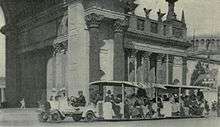Fageol
Coordinates: 37°44′19″N 122°09′58″W / 37.738644°N 122.166240°W

Fageol Motors was a U.S. manufacturer of buses, trucks and farm tractors.
History
The company was founded by Rollie, William, Frank and Claude Fageol in 1916 to manufacture motor trucks, farm tractors and automobiles in Oakland, California.[1] It was located next to the Chevrolet factory originally built in 1917 by William Durant, which later became part of GM.
Fageol produced two luxury automobiles, but production was halted when the supply of Hall-Scott SOHC six-cylinder engines was diverted to build airplanes for the World War I effort.
The initial Fageol farm tractor was a re-labeled Hamilton model, designed and built by Rush Hamilton of Geyserville, California. As a result of the many tractor performance trials of the day, the tractor was redesigned to be more compatible with the needs of the West Coast. The Fageol version was designed by a team led by Horatio Smith with the cooperation of Hamilton. In about 1923, the tractor business was sold to the Great Western Motors Company of San Jose. Hamilton and Smith went with the sale.
In 1921, Fageol became the first company to build a bus from the ground up. This new style bus was initially called "Safety Bus".[2] The goal was to build a bus that was resistant to overturning when cornering. It had a wide track, and was lower to the ground for ease of entry and exit. Following the successful introduction, the vehicles were renamed "Safety Coaches", a term intended to imply greater value.
Fageol trucks were well built and became favorites of the industry, owing in part to the dual range, mid-mounted transmission. This gearbox allowed for extreme ranges in gearing for slow speed heavy hauling and for highway speeds with lighter loads. These vehicles were easily spotted by the large number "7" painted on the front of the radiator.
The Fageol brothers left the company in 1927 to form the Twin Coach Company, manufacturing buses in Kent, Ohio.

The company led by the President, L.H. Bill, did not survive the depression of the early 1930s. It went into receivership, and the bank assumed control and re-organized under the name Fageol Truck and Coach. In 1938, T. A. Peterman bought the factory and its contents. In 1939, the first Peterbilt was produced in the Fageol tradition of building the best possible product.
The South Australian Railways (SAR) operated a number of Fageol buses. In 1932 that system introduced into service the first of four railcars converted from their road buses. These vehicles initially operated on the SAR 3 ft 6 in (1,067 mm) gauge Port Lincoln Division, however some were transferred to the South East Division branch line to Kingston, South Australia, prior to the line's conversion to 5 ft 3 in (1,600 mm) broad gauge. The last railcar was condemned in 1961.[3]
Products
- Fageol Tractors
- Fageol Trucks
- Safety Coach
Cars
Buses
- Twin Coach 44S co-manufactured with J. G. Brill Company and Twin Coach
Imogen Cunningham Photograph
Photographer Imogen Cunningham took a distinctive artistic photograph at the Fageol factory in Oakland titled "Fageol Ventilators" (1934). A print of this photo has been exhibited at "Imogen Cunningham:In Focus" at the Museum of Fine Arts in Boston in 2016-17. [6]
See also
- Flxible
- Twin Coach, another company founded by the Fageol brothers
- book "Fun at Work, Hudson Style (Tales from the Hudson Motor Company)" by Harry F. Kraus
References
- ↑ Vintage Tractors. Fageol
- ↑ Eckermann, Eric; Peter L. Albrecht (2001). World History of the Automobile. SAE International. p. 129. ISBN 0-7680-0800-X.
- ↑ Australian Railway Historical Society Bulletin, October, 1986 pp219-238
- ↑
- ↑
- ↑ Meyers, William (22 September 2016). "Her Life of Blooming Creativity". Wall Street Journal. p. D5.
External links
| Wikimedia Commons has media related to Fageol vehicles. |
- Oakland History Room, photo collection. Fageol Motors. Groundbreaking ceremony at Foothill Blvd and 106th, Oakland, California, June 9, 1917
- Oakland History Room, photo collection. Fageol Motors. First unit under construction in Oakland
- Oakland History Room, photo collection. Fageol Motors. Another view of the factory under construction, with a Fageol truck in the foreground
- Oakland History Room, photo collection. Fageol Motors. Second unit under construction
- Oakland History Room, photo collection. Hall-Scott Motor Company. 150 horsepower straight-6 engines being assembled were formerly destined for Fageol products